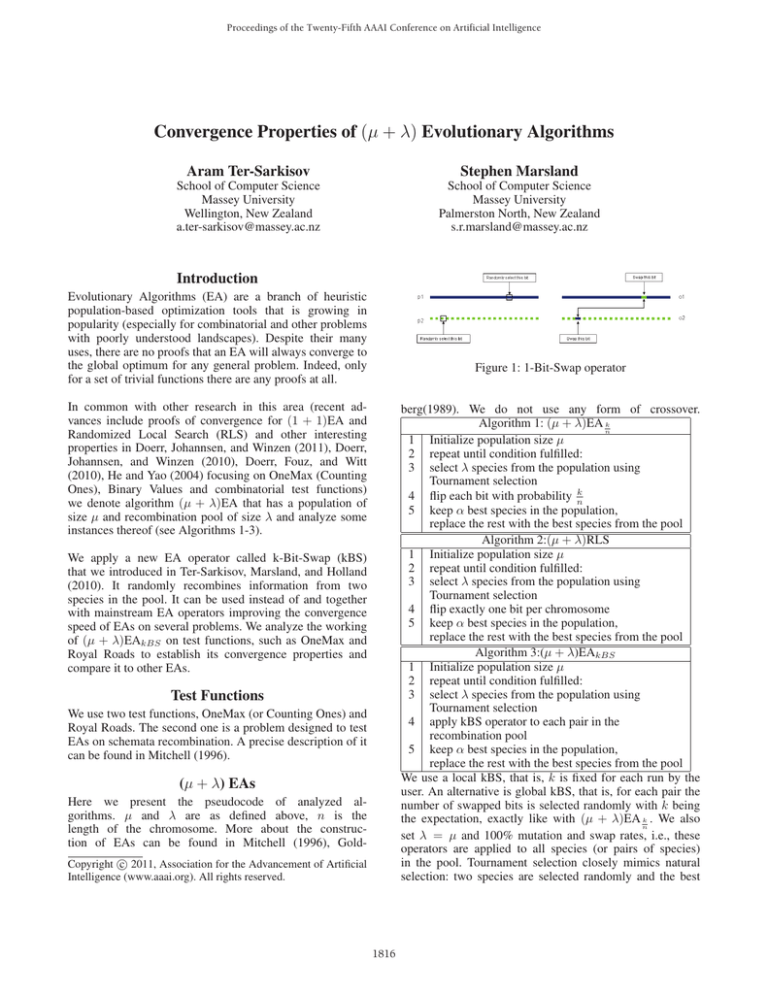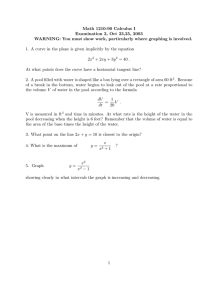
Proceedings of the Twenty-Fifth AAAI Conference on Artificial Intelligence
Convergence Properties of (μ + λ) Evolutionary Algorithms
Aram Ter-Sarkisov
Stephen Marsland
School of Computer Science
Massey University
Wellington, New Zealand
a.ter-sarkisov@massey.ac.nz
School of Computer Science
Massey University
Palmerston North, New Zealand
s.r.marsland@massey.ac.nz
Introduction
Evolutionary Algorithms (EA) are a branch of heuristic
population-based optimization tools that is growing in
popularity (especially for combinatorial and other problems
with poorly understood landscapes). Despite their many
uses, there are no proofs that an EA will always converge to
the global optimum for any general problem. Indeed, only
for a set of trivial functions there are any proofs at all.
Figure 1: 1-Bit-Swap operator
In common with other research in this area (recent advances include proofs of convergence for (1 + 1)EA and
Randomized Local Search (RLS) and other interesting
properties in Doerr, Johannsen, and Winzen (2011), Doerr,
Johannsen, and Winzen (2010), Doerr, Fouz, and Witt
(2010), He and Yao (2004) focusing on OneMax (Counting
Ones), Binary Values and combinatorial test functions)
we denote algorithm (μ + λ)EA that has a population of
size μ and recombination pool of size λ and analyze some
instances thereof (see Algorithms 1-3).
berg(1989). We do not use any form of crossover.
Algorithm 1: (μ + λ)EA k
n
1 Initialize population size μ
2 repeat until condition fulfilled:
3 select λ species from the population using
Tournament selection
4 flip each bit with probability nk
5 keep α best species in the population,
replace the rest with the best species from the pool
Algorithm 2:(μ + λ)RLS
1 Initialize population size μ
2 repeat until condition fulfilled:
3 select λ species from the population using
Tournament selection
4 flip exactly one bit per chromosome
5 keep α best species in the population,
replace the rest with the best species from the pool
Algorithm 3:(μ + λ)EAkBS
1 Initialize population size μ
2 repeat until condition fulfilled:
3 select λ species from the population using
Tournament selection
4 apply kBS operator to each pair in the
recombination pool
5 keep α best species in the population,
replace the rest with the best species from the pool
We use a local kBS, that is, k is fixed for each run by the
user. An alternative is global kBS, that is, for each pair the
number of swapped bits is selected randomly with k being
the expectation, exactly like with (μ + λ)EA k . We also
n
set λ = μ and 100% mutation and swap rates, i.e., these
operators are applied to all species (or pairs of species)
in the pool. Tournament selection closely mimics natural
selection: two species are selected randomly and the best
We apply a new EA operator called k-Bit-Swap (kBS)
that we introduced in Ter-Sarkisov, Marsland, and Holland
(2010). It randomly recombines information from two
species in the pool. It can be used instead of and together
with mainstream EA operators improving the convergence
speed of EAs on several problems. We analyze the working
of (μ + λ)EAkBS on test functions, such as OneMax and
Royal Roads to establish its convergence properties and
compare it to other EAs.
Test Functions
We use two test functions, OneMax (or Counting Ones) and
Royal Roads. The second one is a problem designed to test
EAs on schemata recombination. A precise description of it
can be found in Mitchell (1996).
(μ + λ) EAs
Here we present the pseudocode of analyzed algorithms. μ and λ are as defined above, n is the
length of the chromosome. More about the construction of EAs can be found in Mitchell (1996), Goldc 2011, Association for the Advancement of Artificial
Copyright Intelligence (www.aaai.org). All rights reserved.
1816
where S is at least 1 new elite species in th next population, Hj is the number of elite pairs in the recombination pool and Ak is the number of elite species
in the current population. Next thing we will do is a
continuous-time approximation. We are interested in the
expected number of improvements occurring
in the interval
n
kp
[s, t) : E[N (s, t)] = m(s, t) =
k (s, t) where
k=1
pk (s, t) is the probability of occurrence of k events in this
interval.
one enters the pool.
Analysis basics
EA convergence can be modeled with probabilistic tools,
e.g. martingales that are also known as drift function (see
Doerr, Johannsen, and Winzen [2010], He and Yao [2004])
in EA theory. The value of the best species in the population
is a stochastic process Xt,t≥1 . Among other properties, we
are interested in the expectation of the least time Xt takes to
hit a specific value (or set of values) A. In MC analysis this
is denoted by τA = min t : Xt ∈ A. Specifically, we want it
to be at least finite.
Eτ1A =
∞
tP[τ = t]
In case these arrivals are homogeneous (do not depend on
time), the number of improvements over period [t − s]
follows Poisson distribution with intensity λ(t − s). This
implies interarrival times Tn are exponentially distributed.
We will also analyze cases without this assumption (Polya
process).
(1)
t=1
which under certain assumptions is a version of couponcollector problem, or the sum of Geometric random
variables with a changing parameter. So far in Doerr, Johannsen, and Winzen (2011), Doerr, Fouz, and Witt (2010)
the upper and lower bounds for (1 + 1)EA n1 optimizing
linear functions were found to be (1 + o(1))1.39e ln n and
(1 − o(1))en ln n respectively, n being the length of the
chromosome (assuming starting fitness value was n2 ).
Expected Outcomes
We will derive expectation of runtime for the three
population-based elitist EAs applying different operators on
two test functions and compare to the existing findings to
prove the benefit of population and efficiency of the operators, especially k-Bit-Swap. We will look at other stochastic properties (mean of the population, nonelitist algorithms,
continuous approximation, etc.).
For (μ + λ)EA1BS the increments each generation is
a random variable ξt with distribution
0 with probability 1 − pt
(2)
ξt =
1 with probability pt
Conclusions
In this abstract we have outlined certain ways of analyzing
the evolution of an elitist (μ + λ)EA solving some test problems. We presented some important notions, such as first
hitting time, selection probability, etc used to derive these
expressions. Analysis in the area of population-based algorithms is fairly limited and this research will be a worthy
addition.
therefore, the best chromosome in the population
t is the sum
n
of these increments over time t : Xt = 2 + k=1 ξt . Distribution in Equation 2 changes over time due to the proportion
of 1’s in the recombination pool, so E[ξt+1 |ξt ] = E[ξt+1 ].
The roughest way of going about this issue is to find upper
and lower bounds on the success probability. A better way
is to apply the above-mentioned coupon-collector problem
that for (1 + 2)EA1BS yields a very sharp upper bound:
Eτ ≤ .98n + .5n log n + 1
(3)
which was obtained using the probability of successful
swap in the two offsprings in the pool: pswap = 12 − 2( nk )2
where k denotes the number of 1’s in each parent.
References
Doerr, B.; Fouz, M.; and Witt, C. 2010. Quasirandom Evolutionary Algorithm. In Genetic and Evolutionary Computing
Conference (GECCO) 2010, 1457–1464.
Doerr, B.; Johannsen, D.; and Winzen, C. 2010. Multiplicative Drift Analysis. In Genetic and Evolutionary Computing
Conference (GECCO) 2010, 1449–1456.
Doerr, B.; Johannsen, D.; and Winzen, C. 2011. Multiplicative Drift Analysis. In press.
Goldberg, D. E. 1989. Genetic Algorithms in Search, Optimization and Machine Learning. Reading, Massachussetts:
Addison-Wesley.
He, J., and Yao, X. 2004. A study of drift analysis for estimating computation time of evolutionary algorithm. Natural
Computing 3:21–35.
Mitchell, M. 1996. An Introduction to Genetic Algorithms.
Cambridge, Massachussetts: MIT Press.
Ter-Sarkisov, A.; Marsland, S.; and Holland, B. 2010. The
k-Bit-Swap: A New Genetic Algorithm Operator. In Genetic
and Evolutionary Computing Conference (GECCO) 2010,
815–816.
We need to take into consideration that population μ
consists of two disjoint subsets αt ∪ βt , where αt is the set
of all best species and βt is the rest, so the expectation of
increment ξt and runtime Eτ depend on the proportion αt
in the population. Since kBS crucially depends on pairing
elite species, the probability to pair them using Tournament
selection is
α2 (α + 2β)2
(4)
psel =
μ4
Since we do not know the actual proportion of elite species
in the population, we need to account for each case: 1 ≤
αt ≤ μ and apply Law of total probability:
λ
P (S) =
2
j=1
P (S|Hj )
μ
P (Hj |Ak )P (Ak )
(5)
k=1
1817




